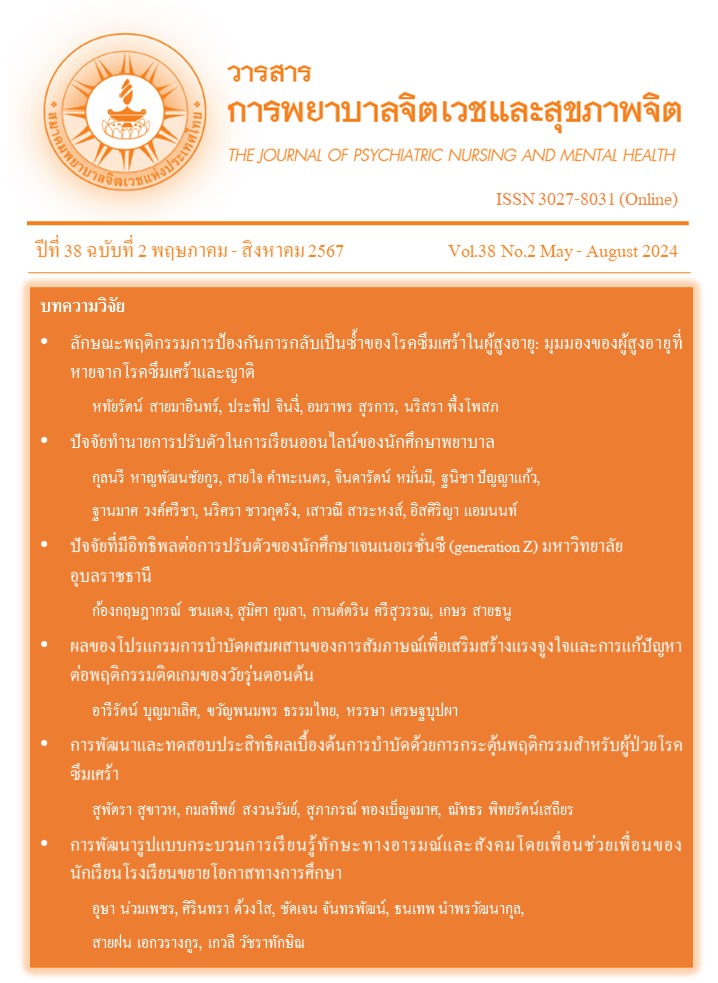การพัฒนาและทดสอบประสิทธิผลเบื้องต้นการบำบัดด้วยการกระตุ้นพฤติกรรมสำหรับผู้ป่วยโรคซึมเศร้า
Main Article Content
บทคัดย่อ
วัตถุประสงค์ : เพื่อพัฒนาและทดสอบประสิทธิผลเบื้องต้นของการบำบัดด้วยการกระตุ้นพฤติกรรมสำหรับผู้ป่วยโรคซึมเศร้า
วิธีการศึกษา : เป็นการวิจัยและพัฒนา โดยใช้วิธีการวิจัยแบบผสมผสาน ประกอบด้วย 2 ระยะ ระยะที่ 1 พัฒนาโปรแกรมการบำบัด โดยการสนทนากลุ่มในผู้ป่วยโรคซึมเศร้าอายุ 18 - 35 ปี จำนวน 37 คน แบ่งเป็น 5 กลุ่ม กลุ่มละ 4 - 10 คน ในผู้มีภาวะซึมเศร้าที่อาศัยอยู่ในจังหวัดอุบลราชธานี ยโสธรและศรีสะเกษ ร่วมกับการทบทวนวรรณกรรม จัดทำต้นร่างโปรแกรมและวิเคราะห์ความตรงเชิงเนื้อหาร่วมกับผู้ทรงคุณวุฒิ ระยะที่ 2 ทดสอบประสิทธิผลของโปรแกรมในรูปแบบการวิจัยเชิงทดลองแบบกลุ่มเดียว กลุ่มตัวอย่างเป็นผู้มีภาวะซึมเศร้า อายุ 18 - 35 ปี ที่มารับบริการในโรงพยาบาลพระศรีมหาโพธิ์ จำนวน 19 คน เครื่องมือที่ใช้ระยะที่ 1 ใช้แนวคำถามในการสนทนากลุ่ม ระยะที่ 2 คือโปรแกรมที่พัฒนาขึ้นและแบบประเมินอาการซึมเศร้า 9 คำถาม ภาษากลางฉบับปรับปรุง ประเมินความแตกต่างของอาการซึมเศร้า เปรียบเทียบก่อนและหลังสิ้นสุดการบำบัดทันที และ 1 เดือน หลังการบำบัด จากสถิติ Repeated measures ANOVA
ผลการศึกษา : โปรแกรมการบำบัดด้วยการกระตุ้นพฤติกรรมเป็นการบำบัดรายบุคคล ประกอบด้วยกิจกรรม 9 ครั้งจาก ครั้งที่ 0-8 แต่ละ ครั้งใช้เวลา 60 นาที ผลการทดสอบเบื้องต้นในกลุ่มตัวอย่าง 13 คน มีอายุเฉลี่ย 25.62 ปี ส่วนใหญ่เป็น เพศหญิง 9 คน เพศชาย 4 คน หลังสิ้นสุดการบำบัด กลุ่มตัวอย่างมีอาการซึมเศร้าลดลงอย่างมีนัยสำคัญสถิติเมื่อเปรียบเทียบกับก่อนการบำบัด ทั้งในระยะหลังสิ้นสุดการทดลองทันที และ 1 เดือนหลังสิ้นสุดโปรแกรม (p-value = 0.001, p-value = 0.002) ตามลำดับ
สรุป : โปรแกรมการบำบัดด้วยการกระตุ้นพฤติกรรม ช่วยให้ผู้มีภาวะซึมเศร้ามีอาการลดลงได้ สามารถนำไปใช้ในการบำบัดผู้มีภาวะซึมเศร้า ทั้งนี้ผู้บำบัดต้องผ่านการอบรมการใช้โปรแกรม
Article Details

อนุญาตภายใต้เงื่อนไข Creative Commons Attribution-NonCommercial-NoDerivatives 4.0 International License.
บทความที่ได้รับการตีพิมพ์แล้ว เป็นลิขสิทธิ์ของสมาคมพยาบาลจิตเวชแห่งประเทศไทย
เอกสารอ้างอิง
Armento, M., McNulty, J., & Hopko, D. (2012). Behavioral activation of religious behaviors (BARB): Randomized trial with depressed college students. Psychology of Religion and Spirituality, 4, 206-222.
Auerbach, R. P., Mortier, P., Bruffaerts, R., Alonso, J., Benjet, C., Cuijpers, P., Demyttenaere, K., Ebert, D. D., Green, J. G., Hasking, P., Murray, E., Nock, M. K., Pinder-Amaker, S., Sampson, N. A., Stein, D. J., Vilagut, G., Zaslavsky, A. M., & Kessler, R. C. (2018). WHO World Mental Health Surveys International College Student Project: Prevalence and distribution of mental disorders. Journal of Abnormal Psychology, 127(7), 623-638.
Dimidjian, S., Barrera, M., Jr., Martell, C., Muñoz, R. F., & Lewinsohn, P. M. (2011). The origins and current status of behavioral activation treatments for depression. Annual Review of Clinical Psychology, 7, 1-38.
Ekers, D., Webster, L., Van Straten, A., Cuijpers, P., Richards, D., & Gilbody, S. (2014). Behavioural activation for depression; an update of meta-analysis of effectiveness and subgroup analysis. PLoS One, 9(6), e100100.
Gawrysiak, M., Nicholas, C., & Hopko, D. R. (2009). Behavioral activation for moderately depressed university students: Randomized controlled trial. Journal of Counseling Psychology, 56, 468-475.
Gutiérrez-Rojas, L., Porras-Segovia, A., Dunne, H., Andrade-González, N., & Cervilla, J. A. (2020). Prevalence and correlates of major depressive disorder: a systematic review. Brazilian Journal of Psychiatry, 42(6), 657-672.
Hopko, D., Armento, M., Robertson, S., Ryba, M., Carvalho, J., Colman, L., Mullane, C., Gawrysiak, M., Bell, J., McNulty, J., & Lejuez, C. (2011). Brief Behavioral Activation and Problem-Solving Therapy for Depressed Breast Cancer Patients: Randomized Trial. Journal of consulting and clinical psychology, 79, 834-849.
Kongsuk, T., Arunpongpaisal, S., Janthong, S., Prukkanone, B., Sukhawaha, S., & Leejongpermpoon, J. (2018). Criterion-Related Validity of the 9 Questions Depression Rating Scale revised for Thai Central Dialect. Journal of The Psychiatric Association of Thailand, 63(3), 321-334.
Lewinsohn, P. M. (1974). A behavioral approach to depression. In R. J. Friedman & M. M. Katz (Eds.), The psychology of depression: Contemporary theory and research. John Wiley & Sons.
Lorenzo-Luaces, L., & Dobson, K. S. (2019). Is behavioral activation (BA) more effective than cognitive therapy (CT) in severe depression? A reanalysis of a landmark trial. International Journal of Cognitive Therapy, 12, 73-82.
Martin, F., & Oliver, T. (2019). Behavioral activation for children and adolescents: a systematic review of progress and promise. European Child and Adolescent Psychiatry, 28(4), 427-441.
Myles, L., & Merlo, E. (2022). Elucidating the Cognitive Mechanisms Underpinning Behavioural Activation. International Journal of Psychological Research, 15(1), 126-132.
Shorey, S., Ng, E. D., & Wong, C. H. J. (2022). Global prevalence of depression and elevated depressive symptoms among adolescents: A systematic review and meta-analysis. British Journal of Clinical Psychology, 61(2), 287-305.
Takagaki, K., Okamoto, Y., Jinnin, R., Mori, A., Nishiyama, Y., Yamamura, T., Yokoyama, S., Shiota, S., Okamoto, Y., Miyake, Y., Ogata, A., Kunisato, Y., Shimoda, H., Kawakami, N., Furukawa, T. A., & Yamawaki, S. (2016). Behavioral activation for late adolescents with subthreshold depression: a randomized controlled trial. European Child & Adolescent Psychiatry, 25(11), 1171-1182.
Tindall, L., Mikocka-Walus, A., McMillan, D., Wright, B., Hewitt, C., & Gascoyne, S. (2017). Is behavioural activation effective in the treatment of depression in young people? A systematic review and meta-analysis. Psychology and Psychotherapy: Theory, Research and Practice, 90(4), 770-796.
World Health Organization. (2019). Depressive disorder (depression). https://www.who.int/news-room/fact-sheets/ detail/depression


